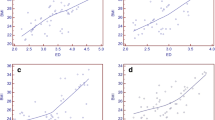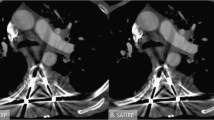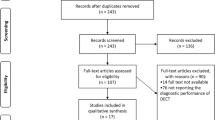Abstract
Objectives
To compare the scan acquisition time, radiation dose, subjective and objective image quality of two dual-source CT scanners (DSCT) for detection of acute pulmonary embolism.
Methods
Two hundred twenty-one scans performed on the 2nd-generation DSCT and 354 scans on the 3rd-generation DSCT were included in this large retrospective study. In a randomized blinded design, two radiologists independently reviewed the scans using a 5-point Likert scale. Radiation dose and objective image quality parameters were calculated.
Results
Mean acquisition time was significantly lower in the 3rd-generation DSCT (2.81 s ± 0.1 in comparison with 9.7 s ± 0.15 [mean ± SD] respectively; p < 0.0001) with the 3rd generation 3.4 times faster. The mean subjective image quality score was 4.33/5 and 4/5 for the 3rd- and 2nd-generation DSCT respectively (p < 0.0001) with strong interobserver reliability agreement. DLP, CTDIvol, and ED were significantly lower in the 3rd than the 2nd generation (175.6 ± 63.7 mGy cm; 5.3 ± 1.9 mGy and 2.8 ± 1.2 mSv in comparison with 266 ± 255 mGy.cm; 7.8 ± 2.2 mGy and 3.8 ± 4.3 mSv). Noise was significantly lower in the 3rd generation (p < 0.01). Signal-to-noise ratio (SNR), contrast-to-noise ratio (CNR), and figure of merit (FOM), a dose-insensitive index for CNR, were significantly higher in the 3rd-generation DSCT (33.5 ± 23.4; 29.0 ± 21.3 and 543.7 ± 1037 in comparison with 23.4 ± 17.7; 19.4 ± 16.0 and 170.5 ± 284.3).
Conclusion
Objective and subjective image quality are significantly higher on the 3rd-generation DSCT with significantly lower mean acquisition time and radiation dose.
Key Points
• The 3rd-generation DSCT scanner provides an improved image quality, less perceived artifacts, and lower radiation dose in comparison with the 2nd-generation DSCT, when operating in dual-energy (DE) mode.
• The 3.4-times-faster 3rd-generation DSCT scanner can be of particular value in patients with chronic lung diseases or breathing difficulties that prevent adequate breathhold.





Similar content being viewed by others
Abbreviations
- ADMIRE:
-
Advanced Modeled Iterative Reconstruction
- BMI:
-
Body mass index
- CNR:
-
Contrast-to-noise ratio
- CTPA:
-
Computed tomography pulmonary angiogram
- DECT:
-
Dual-energy computed tomography
- DSCT:
-
Dual-source computed tomography
- ED:
-
Effective dose
- FOM:
-
Figure of merit
- FOV:
-
Field of view
- ICOPER:
-
International Cooperative Pulmonary Embolism Registry
- PE:
-
Pulmonary embolism
- PEO:
-
Population-exposure-outcome
- SAFIRE:
-
Sinogram-affirmed iterative reconstruction
- SECT:
-
Single-energy computed tomography
- SSCT:
-
Single-source computed tomography
References
Carson JL, Kelley MA, Duff A et al (1992) The clinical course of pulmonary embolism. N Engl J Med 326(19):1240-1245. https://doi.org/10.1056/NEJM199205073261902
Goldhaber SZ, Visani L, De Rosa M (1999) Acute pulmonary embolism: clinical outcomes in the international cooperative pulmonary embolism registry (icoper). Lancet 353:1386-1389. https//doi.org/10.1016/S0140-6736(98)07534-5
Stein PD, Fowler SE, Goodman LR et al (2006) Multidetector computed tomography for acute pulmonary embolism. N Engl J Med 354:2317-2327. https://doi.org/10.1056/NEJMoa052367
Raja AS, Greenberg JO, Qaseem A et al (2015) Evaluation of patients with suspected acute pulmonary embolism: best practice advice from the clinical guidelines committee of the american college of physicians. Ann Intern Med 163(9):701-711. https://doi.org/10.7326/M14-1772
Zhang L-J, Zhao Y-E, Wu S-Y et al (2009) Pulmonary embolism detection with dual-energy ct: experimental study of dual-source ct in rabbits. Radiology 252(1):61-70. https://doi.org/10.1148/radiol.2521081682
Lu G-M, Wu S-Y, Yeh BM, Zhang L-J (2010) Dual-energy computed tomography in pulmonary embolism. Br J Radiol 83(992):707-718. https://doi.org/10.1259/bjr/16337436
Otrakji A, Digumarthy SR, Lo Gullo R, Flores EJ, Shepard J-AO, Kalra MK (2016) Dual-energy ct: spectrum of thoracic abnormalities. Radiographics 36(1):38-52. https://doi.org/10.1148/rg.2016150081
Faby S, Kuchenbecker S, Sawall S et al (2015) Performance of today’s dual energy ct and future multi energy ct in virtual non-contrast imaging and in iodine quantification: a simulation study. Med Phys 42(7):4349-4366. https://doi.org/10.1118/1.4922654
Grajo JR, Patino M, Prochowski A, Sahani DV (2016) Dual energy ct in practice: basic principles and applications. Appl Radiol 45:6+
Lenga L, Albrecht MH, Othman AE et al (2017) Monoenergetic dual-energy computed tomographic imaging: cardiothoracic applications. J Thorac Imaging 32(3):151-158. https://doi.org/10.1097/RTI.0000000000000259
Yu L, Primak AN, Liu X, McCollough CH (2009) Image quality optimization and evaluation of linearly mixed images in dual-source, dual-energy ct. Med Phys 36(3):1019-1024. https://doi.org/10.1118/1.3077921
Borhani AA, Kulzer M, Iranpour N et al (2017) Comparison of true unenhanced and virtual unenhanced (vue) attenuation values in abdominopelvic single-source rapid kilovoltage-switching spectral CT. Abdom Radiol (NY) 42(3):710-717. https://doi.org/10.1007/s00261-016-0991-5
Weidman EK, Plodkowski AJ, Halpenny DF et al (2018) Dual-energy ct angiography for detection of pulmonary emboli: incremental benefit of iodine maps. Radiology 289(2):546-553. https://doi.org/10.1148/radiol.2018180594
Zhang LJ, Zhou CS, Schoepf UJ et al (2013) Dual-energy ct lung ventilation/perfusion imaging for diagnosing pulmonary embolism. Eur Radiol 23(10):2666-2675. https://doi.org/10.1007/s00330-013-2907-x
Geyer LL, Scherr M, Körner M et al (2012) Imaging of acute pulmonary embolism using a dual energy ct system with rapid kvp switching: initial results. Eur J Radiol 81(12):3711-3718. https://doi.org/10.1016/j.ejrad.2011.02.043
Pontana F, Faivre J-B, Remy-Jardin M et al (2008) Lung perfusion with dual-energy multidetector-row ct (mdct): feasibility for the evaluation of acute pulmonary embolism in 117 consecutive patients. Acad Radiol 15(12):1494-1504. https://doi.org/10.1016/j.acra.2008.05.018
Shefer E, Altman A, Behling R et al (2013) State of the art of ct detectors and sources: a literature review. Curr Radiol Rep 1:76-91. https://doi.org/10.1007/s40134-012-0006-4
Doerner J, Hauger M, Hickethier T et al (2017) Image quality evaluation of dual-layer spectral detector ct of the chest and comparison with conventional ct imaging. Eur J Radiol. https://doi.org/10.1016/j.ejrad.2017.05.016
Lenga L, Trapp F, Albrecht MH et al (2019) Single- and dual-energy CT pulmonary angiography using second- and third-generation dualsource ct systems: comparison of radiation dose and image quality. Eur Radiol 29:4603-4612. https://doi.org/10.1007/s00330-018-5982-1
Lenga L, Leithner D, Peterke JL et al (2019) Comparison of radiation dose and image quality of contrast-enhanced dual-source CT of the chest: single-versus dual-energy and second-versus third-generation technology. AJR Am J Roentgenol 212:741-747. https://doi.org/10.2214/AJR.18.20065
Mangold S, De Cecco CN, Wichmann JL et al (2016) Effect of automated tube voltage selection, integrated circuit detector and advanced iterative reconstruction on radiation dose and image quality of 3rd generation dual-source aortic CT angiography: an intra-individual comparison. Eur J Radiol 85(5):972-978. https://doi.org/10.1016/j.ejrad.2016.02.021
Petritsch B, Kosmala A, Gassenmaier T et al (2017) Diagnosis of pulmonary artery embolism: comparison of single-source CT and 3rd generation dual-source CT using a dual-energy protocol regarding image quality and radiation dose. Rofo 189(06):527-536. https://doi.org/10.1055/s-0043-103089
Wichmann JL, Hardie AD, Schoepf UJ et al (2017) Single- and dual-energy CT of the abdomen: comparison of radiation dose and image quality of 2nd and 3rd generation dual-source ct. Eur Radiol 27(2):642-650. https://doi.org/10.1007/s00330-016-4383-6
Bae KT, Tao C, Gürel S et al (2007) Effect of patient weight and scanning duration on contrast enhancement during pulmonary multidetector CT angiography. Radiology. https://doi.org/10.1148/radiol.2422052132
Ramadan SU, Kosar P, Sonmez I, Karahan S, Kosar U (2010) Optimisation of contrast medium volume and injection-related factors in ct pulmonary angiography: 64-slice CT study. Eur Radiol. https://doi.org/10.1007/s00330-010-1782-y
Viteri-Ramírez G, García-Lallana A, Simón-Yarza I et al (2012) Low radiation and low-contrast dose pulmonary ct angiography: comparison of 80 kvp/60 ml and 100 kvp/80 ml protocols. Clin Radiol. https://doi.org/10.1016/j.crad.2011.11.016
McLaughlin PD, Liang T, Homiedan M et al (2015) High pitch, low voltage dual source ct pulmonary angiography: assessment of image quality and diagnostic acceptability with hybrid iterative reconstruction. Emerg Radiol. https://doi.org/10.1007/s10140-014-1230-4
Wu C, Sodickson A, Cai T et al (2010) Comparison of respiratory motion artifact from craniocaudal versus caudocranial scanning with 64-mdct pulmonary angiography. AJR Am J Roentgenol. https://doi.org/10.2214/AJR.09.3673
Mayo-Smith WW, Hara AK, Mahesh M, Sahani DV, Pavlicek W (2014) How I do it: managing radiation dose in CT. Radiology. https://doi.org/10.1148/radiol.14132328
Fanous R, Kashani H, Jimenez L, Murphy G, Paul NS (2012) Image quality and radiation dose of pulmonary CT angiography performed using 100 and 120 kvp. AJR Am J Roentgenol. https://doi.org/10.2214/AJR.11.8208
Sarma A, Heilbrun ME, Conner KE, Stevens SM, Woller SC, Elliott CG (2012) Radiation and chest CT scan examinations: what do we know? Chest. https://doi.org/10.1378/chest.11-2863
Hricak H, Brenner DJ, Adelstein SJ et al (2011) Managing radiation use in medical imaging: a multifaceted challenge. Radiology. https://doi.org/10.1148/radiol.10101157
Rogalla P, Blobel J, Kandel S et al (2010) Radiation dose optimisation in dynamic volume ct of the heart: tube current adaptation based on anterior-posterior chest diameter. Int J Card Imaging. https://doi.org/10.1007/s10554-010-9630-3
Zarb F, Rainford L, McEntee MF (2010) AP diameter shows the strongest correlation with ctdi and dlp in abdominal and chest ct. Radiat Prot Dosim. https://doi.org/10.1093/rpd/ncq115
Schmid AI, Uder M, Lell MM (2016) Reaching for better image quality and lower radiation dose in head and neck CT: advanced modeled and sinogram-affirmed iterative reconstruction in combination with tube voltage adaptation. Dentomaxillofac Radiol. https://doi.org/10.1259/dmfr.20160131
Meyer M, Haubenreisser H, Schoepf UJ et al (2014) Closing in on the k edge: coronary CT angiography at 100, 80, and 70 kv—initial comparison of a second- versus a third-generation dual-source ct system. Radiology 273(2):373-382. https://doi.org/10.1148/radiol.14140244
Funding
The authors state that this work has not received any funding.
Author information
Authors and Affiliations
Corresponding author
Ethics declarations
Guarantor
The scientific guarantor of this publication is Savvas Nicolaou.
Conflict of interest
The authors of this manuscript declare relationships with the following companies: Dr. Savvas Nicolaou and the University of British Columbia have master research agreement with Siemens Healthcare.
Statistics and biometry
No complex statistical methods were necessary for this paper.
Informed consent
Written informed consent was not required for this study because it is a retrospective imaging study.
Ethical approval
Institutional Review Board approval was obtained.
Methodology
• Retrospective
• Cross-sectional study
• Performed at one institution
Additional information
Publisher’s note
Springer Nature remains neutral with regard to jurisdictional claims in published maps and institutional affiliations.
Rights and permissions
About this article
Cite this article
Abdellatif, W., Esslinger, E., Kobes, K. et al. Acquisition time, radiation dose, subjective and objective image quality of dual-source CT scanners in acute pulmonary embolism: a comparative study. Eur Radiol 30, 2712–2721 (2020). https://doi.org/10.1007/s00330-019-06650-6
Received:
Revised:
Accepted:
Published:
Issue Date:
DOI: https://doi.org/10.1007/s00330-019-06650-6




